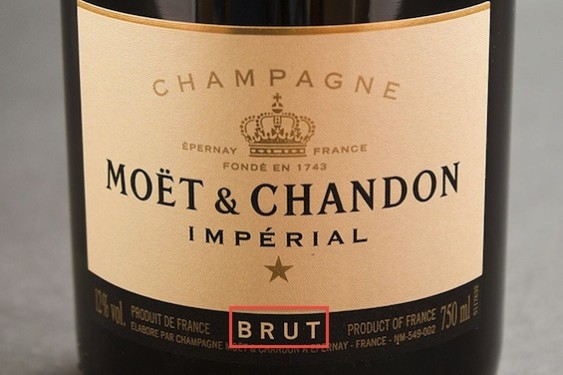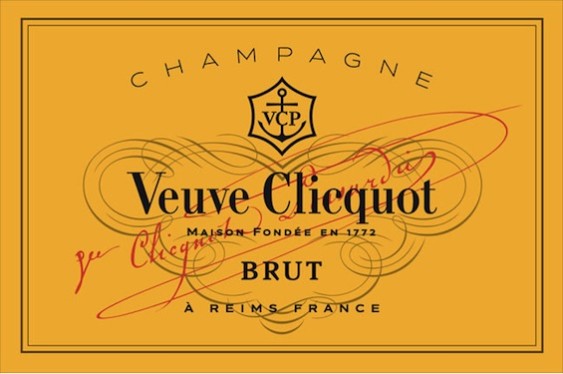December is Champagne Month on Cluster Crush, and while I shared a few basic fun facts in the last post, this one is going to give you a better idea of what all the terms on a champagne label mean…not to mention a possible sweet tooth.
You might think all champagne is pretty much the same – a sparkling white or rosé wine made in the Champagne region of France. But there are actually tons of variations to how the wine can taste based on whether it’s a vintage from a specific year, a non-vintage blend of various years and, most prominently, the level of sweetness.

That “brut” designation is there for more than just decoration.
Perhaps you’ve heard of a style called brut. Literally meaning “rough” or “rude” in French. It’s probably the most popular style for champagne these days (the champagne house Pommery claims to have invented the style back in 1874 ). But that’s just one of several levels of sweetness champagne can be, and you can start looking at labels to figure out which taste you like best.
The level of sweetness of a specific champagne is determined by what’s called the dosage. This is a small amount of sugar or grape must that champagne-makers add back into the finished wine to round out its acidity, provide a little extra body to the wine, and standardize it to the house’s typical flavor style.
Over time, the prevalence of each style has also changed. Most folks in the 18th and 19th century actually preferred a sweeter style of champagne, especially the aristocrats in the Russian imperial court. These days, however, it’s the drier versions that get the love.
Making these designations even more confusing is that some of them include the term sec, which means “dry” in French, but which is actually sweeter than some other styles. From least sweet to sweetest, here are the various champagne designations and what they mean…as well as a comparison to fruit-flavored candy on an equivalent scale, in case that helps!
Brut Nature: The most dry, acidic style of champagne to which no sugar has been added. They typically have 0-3 grams of naturally occurring residual sugar (hence the “nature” designation) per liter. That’s basically less than half a gram of residual sugar per glass. This style was first introduced by famous champagne house Laurent-Perrier in 1889. Sometimes this style is called brut sauvage, or “wild rough,” which sounds a bit kinkier to me. Candy comparison: Sour Patch Kids.
Extra Brut: Sounds like it should be the driest style, right? Wrong. This is actually one level up from Brut Nature and contains less than 6 grams of residual sugar per liter, or less than one gram per glass. Candy comparison: Pixie sticks.
Brut: The next style up, and the most widely available, brut champagnes have less than 12 grams of residual sugar per liter, or about 2 grams per glass. Candy comparison: Nerds.
Extra Dry: Wait, what? How can something called Extra Dry actually be less dry than three other categories? Don’t ask me, I’m just telling you how they’re labeled. Wines with this designation have 12-17 grams of residual sugar per liter, or about 2-3 grams per glass. Candy comparison: Red Vines.
Dry/Sec: Again, not actually that dry, and even fairly sweet to my taste. These wines have 17-32 grams of residual sugar per liter, or between 2.5-5 grams per glass. Candy comparison: Starburst.
Demi-Sec: This literally means “half-dry” in French, but it’s actually quite sweet. These wines have 32-50 grams of residual sugar per liter, or between 5-7.5 grams per glass. Candy comparison: Skittles.
Doux: Finally, a wine whose classification means what it is, “sweet.” These delicious sparklers pack over 50 grams of residual sugar per liter, or over 8 grams per glass usually. Candy comparison: Swedish Fish.

The most popular style of champagne today is brut.
So how to keep it all straight? I don’t have a very good mnemonic device for you because, well, I’d have to figure out a clever formula for the letters BNEBBEDSDSD…and that’s just too hard. For the most part, all you need to remember is that brut will be dry, and dry or sec will actually be sweet.
However, I think the best way to keep all these classifications straight takes some practice and familiarization with the champagne shelf at your local wine shop…so better start reading those bottles and, more importantly, tasting all the champagne you can!
If you think of a good way to remember all these sweetness levels, be sure to tweet it to me @clustercrush!

